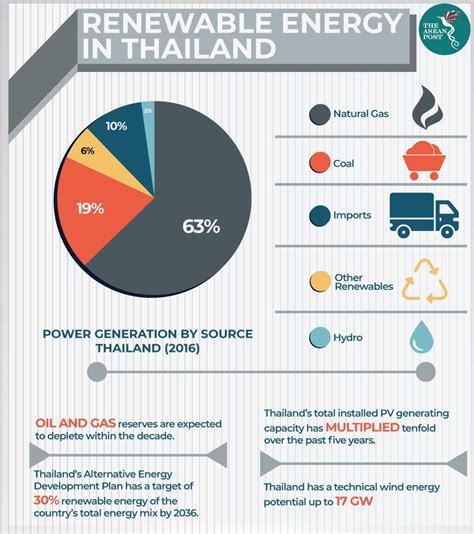Thailand, a country located in the heart of Southeast Asia, has been actively pursuing a transition towards a more sustainable and environmentally friendly energy sector. One of the key strategies employed by the Thai government is the promotion of green power, which encompasses a range of renewable energy sources including solar, wind, hydro, and biomass. The adoption of green power in Thailand is driven by the need to reduce the country's dependence on fossil fuels, mitigate climate change, and ensure a sustainable energy future. In this article, we will explore five ways in which green power is transforming the energy landscape in Thailand.
Key Points
- Thailand aims to increase its renewable energy capacity to 30% of the total energy mix by 2030
- Solar power is the leading source of renewable energy in Thailand, with a target of 6,000 MW of installed capacity by 2030
- Wind power is another significant contributor to Thailand's renewable energy mix, with a target of 3,000 MW of installed capacity by 2030
- Hydro power is the oldest and most established form of renewable energy in Thailand, with a total installed capacity of over 3,000 MW
- Biomass power is a growing sector in Thailand, with a target of 5,600 MW of installed capacity by 2030
Increased Adoption of Solar Power

Solar power is one of the most promising forms of renewable energy in Thailand, with the country aiming to increase its solar power capacity to 6,000 MW by 2030. The Thai government has introduced a range of policies and incentives to encourage the adoption of solar power, including feed-in tariffs, tax breaks, and low-interest loans. As a result, the solar power sector in Thailand has experienced rapid growth, with the number of solar farms and rooftop installations increasing significantly in recent years. According to the Energy Policy and Planning Office (EPPO), the total installed capacity of solar power in Thailand reached 2,500 MW in 2020, up from just 100 MW in 2010.
Wind Power Development
Wind power is another significant contributor to Thailand’s renewable energy mix, with the country aiming to increase its wind power capacity to 3,000 MW by 2030. The Thai government has identified several areas with high wind potential, including the northeastern and southern regions of the country. Several wind farms have already been developed in these areas, with more projects in the pipeline. According to the Thai Wind Energy Association, the total installed capacity of wind power in Thailand reached 1,200 MW in 2020, up from just 10 MW in 2010.
| Renewable Energy Source | Installed Capacity (MW) | Target Capacity (MW) |
|---|---|---|
| Solar Power | 2,500 | 6,000 |
| Wind Power | 1,200 | 3,000 |
| Hydro Power | 3,000 | 3,500 |
| Biomass Power | 1,000 | 5,600 |

Hydro Power Development

Hydro power is the oldest and most established form of renewable energy in Thailand, with a total installed capacity of over 3,000 MW. The Thai government has invested heavily in the development of hydro power, with several large-scale dams constructed in recent decades. Hydro power is a reliable and constant source of energy, making it an important contributor to Thailand’s energy mix. According to the Electricity Generating Authority of Thailand (EGAT), hydro power accounted for 10% of the country’s total electricity generation in 2020.
Biomass Power Development
Biomass power is a growing sector in Thailand, with the country aiming to increase its biomass power capacity to 5,600 MW by 2030. Biomass power is generated from organic matter such as agricultural waste, wood chips, and other plant material. The Thai government has introduced several policies to encourage the development of biomass power, including feed-in tariffs and tax breaks. According to the Thai Biomass Industry Association, the total installed capacity of biomass power in Thailand reached 1,000 MW in 2020, up from just 100 MW in 2010.
What are the benefits of green power in Thailand?
+The benefits of green power in Thailand include reduced greenhouse gas emissions, improved energy security, and increased economic benefits from the development of a low-carbon economy.
What are the challenges facing the development of green power in Thailand?
+The challenges facing the development of green power in Thailand include the high upfront costs of renewable energy technologies, the need for significant investment in grid infrastructure, and the potential environmental and social impacts of large-scale renewable energy projects.
What is the current state of green power development in Thailand?
+The current state of green power development in Thailand is one of rapid growth, with the country aiming to increase its renewable energy capacity to 30% of the total energy mix by 2030. Several large-scale renewable energy projects are currently under development, including solar farms, wind farms, and biomass power plants.
In conclusion, the development of green power in Thailand is a critical component of the country’s energy strategy, with the potential to reduce greenhouse gas emissions, improve energy security, and increase economic benefits. While there are challenges facing the development of green power in Thailand, the long-term benefits make the effort worthwhile. As the country continues to transition towards a low-carbon economy, it is likely that green power will play an increasingly important role in Thailand’s energy mix.



